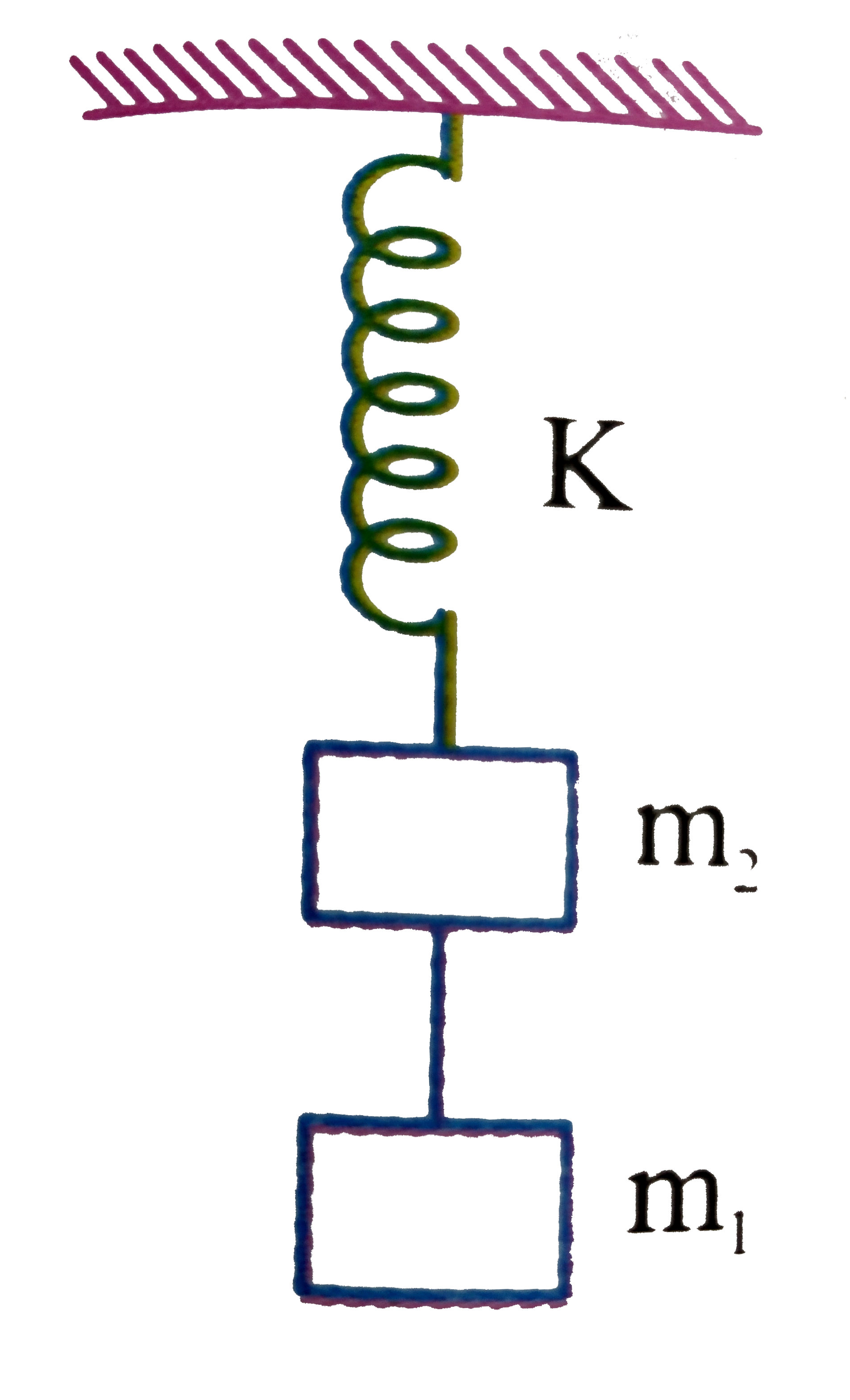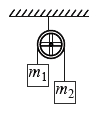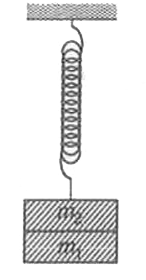Consider an isothernmal cylinder and massless kpiston assembly in which ideal gas is filled . Cross sectional
area of the cylinder = 1m2. Three masses m1,m2andm3 are kept on the piston . When m1 id removed ,
piston moves upon point A. When m1&m2 both are removed piston moves upto jkpint B & when m1
m2&m3 all three are removed , piston moves upto ,lpoint C. Calculate work done by the gas
(in joule) when piston moves from point B to point C.
[Given:m1=2×104kg,m2=3×104kg,g=10m/s2]
![Consider an isothernmal cylinder and massless kpiston assembly in which ideal gas is filled . Cross sectional area of the cylinder = 1m^(2). Three masses m(1),m(2) and m(3) are kept on the piston . When m(1) id removed , piston moves upon point A. When m(1) & m(2) both are removed piston moves upto jkpint B & when m(1) m(2) & m(3) all three are removed , piston moves upto ,lpoint C. Calculate work done by the gas (in joule) when piston moves from point B to point C. [Given : m(1)= 2xx 10 ^(4) kg , m(2) = 3 xx 10 ^(4) kg , g = 10 m//s^(2)]](https://d10lpgp6xz60nq.cloudfront.net/physics_images/BSL_CHM_THRM_S01_035_Q01.png)
Initially piston is at eq,
106=(2×104+3×104+m3)×101+105
m3=(106−10510)−5×104=104(10−1)−5×104=104(9−5)=4×104kg
since T = constant
PiVi=PBVB
106×4=(105+4×105)×VB
VB=4×106105×5=405=8lit.
Also,
PBVB=PCVC lt brgt 105×5×8=105×Vc
Vc=40L
WBC=−Pext(VC_VB)=−105(40−8)×10−3=−3200J
Wby=3200J
Topper's Solved these Questions
- THERMODYNAMICSBook:BANSALChapter:THERMODYNAMICSExercise:Exercise
Explore 14 Videos
- THERMODYNAMICSBook:BANSALChapter:THERMODYNAMICSExercise:Exercise 1
Explore 35 Videos
- THERMODYNAMICSBook:BANSALChapter:THERMODYNAMICSExercise:Exercise 3
Explore 43 Videos
- THERMOCHEMISTRYBook:BANSALChapter:THERMOCHEMISTRYExercise:Exercise 4
Explore 15 Videos
Similar Questions
Select the intensive and extensive propertie from the following :
Entropy , specific entropy , triple point of water , volume of gas , pressure.
View SolutionOut of boiling pont (I), entropy (II), pH (III) and density (IV), Intensive properties are :
View SolutionPredict sigh of work done in following reactions at constant pressure.
View SolutionWhich of the following is not an endothermic reaction?
View SolutionThe lines y=m1x,y=m2xandy=m3x make equal intercepts on the line x+y=1. Then (a) 2(1+m1)(1+m3)=(1+m2)(2+m1+m3) (b)(1+m1)(1+m3)=(1+m2)(1+m1+m3) (c)(1+m1)(1+m2)=(1+m3)(2+m1+m3) (d)2(1+m1)(1+m3)=(1+m2)(1+m1+m3)
View SolutionTwo blocks M_(1) and M_(2) having equal mass are free to move on a horizontal frictionless surface. M_(2) is attached to a massless spring as shown in figure. Initially M_(2) is at rest and M_(1) is moving toward M_(2) with speed upsilon and collides head-on with M_(2) .
View SolutionIf m_(1),m_(2) are masses of an ideal gas, then which of the graph repersents m_(2)gtm_(1) ?.
View SolutionTwo masses m1 and m2 are suspeded togther by a massless spring of spring constnat k (Fig). When the masses are in equilibrium, m1 is removed. Frequency and amplitude of oscillation of m2 are

View SolutionA moving body with a mass m_(1) strikes a stationary body of mass m_(2) . The masses m_(1) and m_(2) should be in the ratio m_(1)/m_(2) so as to decrease the velocity of the first body 1.5 times assuming a perfectly clastic impact. Then the ratio m_(1)/m_(2) is
View SolutionTwo masses m1 and m2(m2>m1) are hanging vertically over frictionless pulley. The acceleration of the two masses is :

View SolutionTwo masses m_(1) and m_(2) are suspended together by a massless spring of constant K. When the masses are in equilibrium, m_(1) is removed without disturbing the system. Then the angular frequency of oscillation of m_(2) is -
View Solutionदो द्रव्यमान m1 व m2 एक द्र्व्यमाणहीन स्प्रिंग से जिसका बल नियतांक k है , लटके हैं। जब दोनों द्रव्यमान साम्यावस्था में हैं, m1 को धीरे से हटा दिया जाता है। m2 के दोलन की कोणीय आवृत्ति तथा आयाम ज्ञात कीजिए ।

View SolutionConsider the case of two bodies of masses m_(1) and m_(2) which are connected by light inextensible string passing over a light smooth pulley as shown in the figure. The expression for acceleration of the system and tension of the string are expressed below under different situations: (i) when m_(1) gt m_(2) . In this case a=((m_(1)-m_(2))/(m_(1)+m_(2)))g and T=((2m_(1)m_(2))/(m_(1)+m_(2)))g (ii) when m_(2) gt m_(1) . In this case a=((m_(2)-m_(1))/(m_(1)+m_(2)))g and T=((2m_(1)m_(2))/(m_(1)+m_(2)))g (iii) When m_(1)=m_(2)=m . In this case a = 0, T = mg If m_(1)=10kg, m_(2)=6kg and g =10m//s^(2) then what is the acceleration of masses?
View SolutionConsider the case of two bodies of masses m_(1) and m_(2) which are connected by light inextensible string passing over a light smooth pulley as shown in the figure. The expression for acceleration of the system and tension of the string are expressed below under different situations: (i) when m_(1) gt m_(2) . In this case a=((m_(1)-m_(2))/(m_(1)+m_(2)))g and T=((2m_(1)m_(2))/(m_(1)+m_(2)))g (ii) when m_(2) gt m_(1) . In this case a=((m_(2)-m_(1))/(m_(1)+m_(2)))g and T=((2m_(1)m_(2))/(m_(1)+m_(2)))g (iii) When m_(1)=m_(2)=m . In this case a = 0, T = mg If the pulley is pulled upward with acceleration equal to the acceleration due to gravity, what will be the tension in the string?
View SolutionTwo blocks M1 and M2 having equal mass are free to move on a horizontal frictionless surface. M2 is attached to a massless spring as shown in figure. Initially M2 is at rest and M1 is moving toward M2 with speed υ and collides head-on with M2.

View Solution
